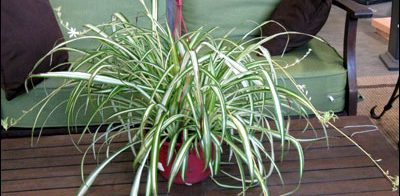Winter is probably the easiest time of year to kill the plant you brought in from the cold. And, the fastest way is by overwatering. Grueling growing conditions like lower light levels, dry air, shorter days and chilly temperatures really stress out plants, which makes them susceptible to insect and disease problems. Then the pests finish them off.
The secret to helping plants survive winter is adjusting care routines to suit seasonal growing conditions. Here are a few things to consider.
Light
In winter, the sun is lower in the sky and light levels near windows drop up to 50 percent. Houseplants that grow near a sunny eastern or northern window in summer may need a southern or western exposure in winter. Likewise, tropical plants that were able to withstand direct sun outside will need to be in the brightest spots possible or may require extra lighting inside. Plants are likely to lose leaves in order to adjust to the light change. The new leaves that grow back will be accustomed to the lower light. Remember that if those plants are going back outside in the spring. They will need to be shaded for a while or the new leaves will sunburn.
To help plants cope with changing light levels:
- Move plants closer to windows, if possible.
- Clean windows to allow maximum light transmission.
- Shift plants to new locations near brighter windows for winter.
- Wash dust off plants so leaves can make maximum use of available light.
- Add artificial light. Fluorescent bulbs provide adequate light. They’re cheaper than traditional grow lights and produce less heat. Position bulbs 4 to 12 inches away from plants for effective results.
Temperature
Most of these plants and prefer temperatures between 65° F and 75° F during the day and about 10-15 degrees cooler at night. For tropical plants, temperatures below 50°F can cause problems. Hopefully, you had the chance to bring them in with the first cool spell a month ago.
Adjust thermostats for your comfort, but remember your plants need some consideration.
- Avoid placing plants near cold drafts or heat sources.
- Keep plants several inches away from exterior windows.
Humidity
Homes may offer only 5-10 percent relative humidity in winter. Houseplants like 40-50 percent. Signs of low humidity stress on plants include brown leaf tips and appearance of pests like spider mites.
- Raise humidity around plants with a room humidifier.
- Place plants on a pebble-lined tray filled with water. Keep the water level just below the pebbles. As the water evaporates, it raises humidity around plants.
- Mist plants with room-temperature water. Avoid wetting walls or furniture.

Water
The most common problem plants suffer from in winter is overwatering. Most plants need soil to dry out almost completely before watering. How can you tell if plants need water?
- Don’t just spot test the soil surface. Plants need water when the root zone is dry. Poke your finger into soil up to 2 inches. If the soil is dry, water.
- Lift the pot. Soil is lighter when it’s dry. Learn how wet soil feels by lifting pots immediately after watering.
- Exceptions to drying out between watering: Potted citrus and ferns require consistently moist soil. Always research plant moisture needs if you’re unsure.
When you do water, never allow plants to sit overnight in water that collects in the drainage saucer.
Fertilizer, Pruning and Repotting
Save these tasks until spring. Winter growth is usually leggy. Prune and fertilize to encourage bushy growth when the sunlight and temperatures increase. The right time to repot most tropical and houseplants is during periods of active growth – in spring and summer. The exception is potted woody plants that go completely dormant in winter. Transplant those prior to bud break in early spring.
- Watch for “Melting Grass” - February 19, 2025
- Palms Can Suffer in the Cold - January 30, 2025
- Camellia Care - January 9, 2025
